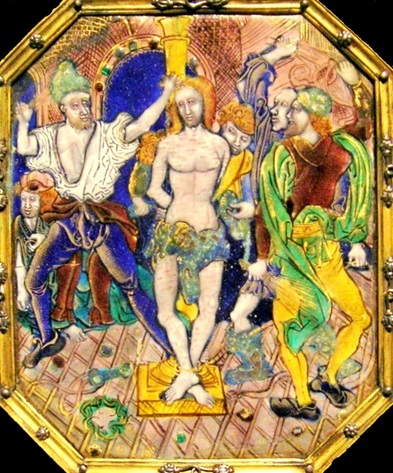Email-peint
ITALIANO. In italiano "smalto dipinto": tecnica in cui gli smalti vengono utilizzati come se fossero normali colori ad olio per dipinti e la superficie di metallo come se fosse una tela. Prima di tutto, si ricopre la placca metallica di fondente su entrambe le superfici e si passa attraverso una prima cottura: il retro della placca metallica è così protetto dall’azione del tempo, mentre il fronte è pronto a ricevere la decorazione. Quest’ultima si ottiene con la sovrapposizione o giustapposizione di più mani di smalto colorato, stesi a pennello come se fossero pittura. Ogni strato si fissa mediante cottura in forno a temperature diverse. La tecnica dello “smalto dipinto” apparve contemporaneamente in Francia e in Italia, Jean Fouquet esegue il suo celebre autoritratto (oggi al Louvre) al ritorno di un viaggio in Italia, dopo aver appreso la tecnica dell’émail-peint" dal Filarete. I migliori artisti combinano questa tecnica con lamine d’oro o d’argento (paillons), per dare più luce soprattutto alle parti che rappresentano gli abiti dei personaggi raffigurati.
A fondo pagina: "Flagellazione", smalto dipinto, Pseudo-Monvaerni, 12 x 16 cm, Limoges, fine XV secolo.
DEUTSCH. Also „Emailmalerei“ auf Deutsch: Technik, wo die Emailfarben sind wie normalen Ölfarben auf eine „Leinwand“ aus Metall. Erst, der Emaillist deckt die Metalloberfläche mit Grundemail and beiden Seiten („Fondant“ und „Contrémail“) und brennt sie im Ofen: die Rückseite wird geschützt und ist fertig für die Dekoration. Dann man breitet die wetten Emailfarben mit einem Pinsel wie Ölmalerei. Jede Schicht von Emailfarben wird im Ofen mit verschiedenen Temperaturen gebrannt. Die Technik der Emailmalerei erschien zugleich in Italien und Frankreich; Jean Fouquet macht seinem bekanntem Selbstporträt (heute im Louvre) zurück von einer Reise in Italien, nach Lernen der Emailmalerei-Technik aus Filarete. Die bessere Künstler kombinieren diese Technik mit Gold- und Silberblätter („Paillons“), um die Kleider der Figuren heller zu machen.
Am unteren Ende der Seite: "Geißelung", Emailmalerei, Pseudo-Monvaerni, 12 x 16 cm, Limoges, Ende des 15. Jahrhunderts.
ENGLISH. In English “painted enamel”: technique that consists of using the enamels as if they were oil painting directly on a “canvas” of metal. First, the enamellist applies ground enamel on both sides of the metal surface (fondant enamel and counter-enamel), and fires it in the kiln: the enamel will protect the back of the metal, while the front is ready to receive the decoration. The latter consists of the superposition or juxtaposition of some layers of diluted coloured enamels with the aid of a brush. Every layer and colour requires a different temperature. The painted enamel technique appears simultaneously in France and Italy; Jean Fouquet produced his famous enamelled self-portrait returning from Italy after learning it from Filarete. The best artists combine this technique with gold or silver sheets named paillon to give more brightness especially to the parts representing the clothes of the subjects.
At the bottom of the page: Flagellation, painted enamel, Pseudo-Monvaerni, 12 x 16 cm, Limoges, 15th century.
FRANÇAIS. L’émail peint est une technique où l’on applique des émaux comme s’ils étaient de la peinture à l’huile, directement sur une « toile » de métal. L’émailleur applique prêt de tout une couche d’émail neutre sur les deux faces du métal (le fondant et le contrémail), et après il cuit l’émail dans la moufle : le derrière du métal est ainsi protégé, tandis-que le devant est prêt à recevoir la décoration. La peinture est obtenue par la superposition ou juxtaposition de diverses couches d’émail coloré dilué, appliqué au pinceau. Chaque couche et couleur exige une température différente. L’émail peint apparaît simultanément en France et en Italie ; Jean Fouquet produisait son célèbre autoportrait à l’émail après son retour de l’Italie, où il avait appris la technique chez le Filarete. Les meilleurs artistes combinent cette technique avec des paillons d’or ou d’argent pour donner de la brillance aux vêtements des sujets.
Au bout de la page: Flagellation, émail peint, Pseudo-Monvaërni, 12 x 16 cm, Limoges, XVème siècle.
ESPAÑOL. En español "esmalte pintado": técnica que consiste en usar los esmaltes como si fueran pintura al óleo directamente sobre un "lienzo" de metal. En primer lugar, el esmaltista aplica el esmalte molido en ambos lados de la superficie metálica (esmalte de fondo y contra-esmalte), y va someterlo a la acción del fuego en el horno: el esmalte protegerá la parte posterior del metal, mientras que el frente está listo para recibir la decoración. Este último consiste en la superposición o yuxtaposición de algunas capas de esmaltes de colores diluidos con la ayuda de un cepillo. Cada capa y color requiere una temperatura diferente. La técnica del esmalte pintado aparece simultáneamente en Francia e Italia; Jean Fouquet produjo su famoso autorretrato esmaltado volviendo de Italia después de aprenderlo de Filarete. Los mejores artistas combinan esta técnica con hojas de oro o plata llamadas paillon para dar más brillo especialmente a las partes que representan la ropa de los sujetos.
A la fin de la página: Flagelación, esmalte pintado, Pseudo-Monvaerni, 12 x 16 cm, Limoges, siglo XV.
